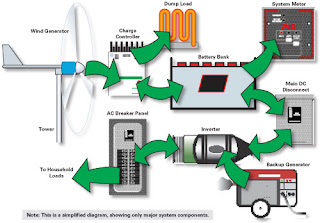Off-Grid Wind-Electric Systems
Off-grid wind-electric systems are battery based. People generally choose these systems because their home or other energy use is not connected to the grid, and connection would be expensive. Others prefer the independence of off-grid systems, or live where utilities and governments make it difficult to tie a renewable energy system to the grid.
Off-grid systems are limited in capacity by the size of the generating sources (wind turbine, solar-electric array, fuel-fired generator, etc.), the resources available, and the battery bank size. Off-grid homeowners have to learn to live within the limitations of their system capacity.
The following illustration includes the primary components of any off-grid wind-electric system with battery backup. See our Wind-Electric System Components section for an introduction to the function(s) of each component.
See also the following Home Power feature articles:
Watts in the Wind
--------------------------------------------------------------------------------
Grid-Tied Wind-Electric System with Battery Backup
Connecting a wind-electric system to the utility grid with battery backup gives you the best of both worlds. You have the unlimited capacity of the grid at your disposal, and you can send your surplus wind energy to the grid. When the grid is down, you can still use your system, within the limitations of the battery bank and turbine. Wind-electric systems can be a much better match for utility backup than solar-electric systems, since many grid outages are caused by high winds. The drawback is that this is the most expensive type of wind-electric system you can install.
The following illustration includes the primary components of any grid-tied wind-electric system with battery backup. See our Wind-Electric System Components section for an introduction to the function(s) of each component.See also the following Home Power feature articles:
The First Small Wind System in Lassen County
Batteryless Grid-Tied Wind-Electric System
Connecting to the grid without batteries is the most cost-effective and environmentally friendly way to go. You eliminate batteries, which are costly, require maintenance, and carry a significant efficiency penalty. The only drawback of batteryless systems is that when the grid is down, your system shuts down. But in most grid-serviced areas, utility outages are only a few hours a year—a small inconvenience to endure for the efficiency, environmental friendliness, and thriftiness of these systems.
Batteryless grid-tie systems may see increased performance (sometimes dramatically) from the wind turbine compared to battery-based systems. This is because the inverter´s electronics can match the wind´s load more exactly, running the turbine at optimum speed, and extracting the maximum energy.
The following illustration includes the primary components of any batteryless grid-tied wind-electric system. See our Wind-Electric System Components section for an introduction to the function(s) of each component.
See also the following Home Power feature articles:
At Last....Simple Wind Grid-TieBetting the Farm—Wind Electricity Pays Off
Farming the Wind
Direct-Drive Batteryless Wind-Electric System
These are the least common wind-electric systems, typically used for water pumping. A turbine is matched to a pump, often through an electronic controller. When the wind blows, water is pumped to an elevated tank, a stock-watering tank, or directly to the land to irrigate. These systems can be simple and cost effective in the right situation. Direct-drive systems are also used for heating, which can be a good match, since it´s normally colder when it´s windy. But heating is a big load, so large turbines are needed.
The following illustration includes the primary components of any batteryless grid-tied wind-electric system. See our Wind-Electric System Components section for an introduction to the function(s) of each component.Wind-Electric System Components
Understanding the basic components of an RE system and how they function is not an overwhelming task. Here are some brief descriptions of the common equipment used in grid-intertied and off-grid wind-electric systems. Systems vary—not all equipment is necessary for every system type.





0 comments:
Post a Comment